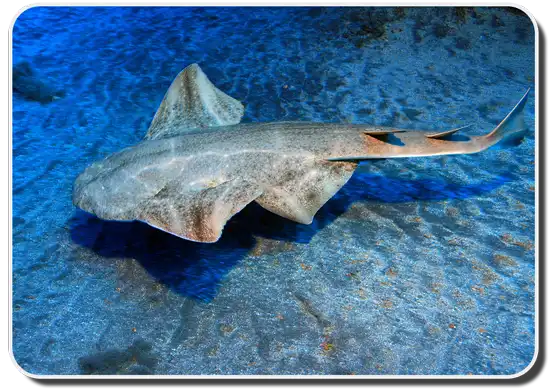Angel Sharks are a really unique species of shark. They have flat bodies and extremely long pelvic and pectoral fins, so they are often mistaken for rays. However, unlike rays, these bottom-dwelling sharks use their long fins to steer.

There are 23 species of Angel Sharks and they are found all over the world, so they are a great shark to learn about.
Here are some interesting facts about Angel Sharks:
- Adult Angel Sharks are usually 5 feet long but some species, like the Japanese Angel Shark can grow up to 6.5 feet.
- An average Angel Shark weighs around 77 pounds.
- In the wild, Angel Sharks can live between 25 and 35 years old.
- Sometimes Angel Sharks are referred to as Monkfish and ironically the “sand devil.”
- Angel Sharks tend to live in shallow temperate waters, though some species like depths of up to 500 feet.
- They are migratory creatures and tend to move toward the poles during seasonal changes, always staying along the coastline.
- They are mostly nocturnal and spend their time hiding just below the surface in the mud or sand. They use the bioluminescent of plankton to see their prey.
- Angel Sharks use camouflage to trap their prey. Their skin is usually mottled with brown, black, grey, green, white, and red spots to look like the mud or sand.
- The underside of an Angel Shark is usually smooth and white.
- Angel Sharks are carnivores that eat fish, mollusks, squid, and various crustaceans. They particularly like flatfishes and skates.
- They are ambush hunters sensing when prey comes near, they strike at a 90 degree angle with a powerful suction, and grab their prey within a 1/10 of a second.
- Angel Sharks tend to bury themselves in flat sandy and muddy areas between rocks near reefs, submarine canyons, and kelp forests where fish are plentiful.
- They tend to hunt from the same place for about ten days then move on to a new spot. They usually stay in small areas of about 50 feet and it is rare to see them in open water unless they are migrating for the season.
- Angel Sharks have eyes on the top of their heads that they use to see their prey.
- Behind the eyes, Angel Sharks have a spiracle which is an unusual type of respiratory device that delivers oxygen straight to the brain.
- Another characteristic that makes Angel Sharks different than rays is they have five gill slits on the sides of their heads instead of underneath.
- They have a very large mouth with razor sharp teeth found at the end of a blunted snout.
- Angels Sharks have nine rows of teeth on the top of their jaw and ten rows of teeth on the bottom jaw with a center space that contains no teeth, perfect for catching and eating their prey.
- At the end of their snout there are also two barbels, sensory organs that act like whiskers to help they detect prey.
- Unlike most sharks, Angel Sharks have no anal fin.
- They also have pectoral fins that are expanded laterally, rather than attached to the sides of the head like most sharks.
- Another feature that makes Angel Sharks different from other sharks is that their upper caudal fin, the fins on the tail, is smaller than their lower caudal fin. This is to help propel them upward to catch prey.
- Angel Sharks have rows of small thorns along the top of their bodies, these thorns are also found on their heads to prevent attack. Though as they get older, they may lose these thorns.
- They are solitary creatures except during mating season. Angel Sharks typically mate in the Springtime in warmer waters.
- Female sharks are ovoviviparous, which means that their young is born in eggs that gestate in their womb until hatched.
- Depending on the size of the Angel Shark, they can have anywhere from 8 to 25 pups in a litter.
Baby Angel fish tend to be 9 to 12 inches long when born.
- Only 20% of all Angel fish pups reach adulthood.
- Juveniles have ocellus, fake eyes, on their bodies to help defend them against predators. These disappear once they’ve reached adulthood.
- Adult Angel Sharks have few predators but have been known to be eaten by great white sharks, the Broadnose Sevengill Shark, Northern Elephant Seals, and humans.
- Angel Sharks are listed as critically endangered.
- The biggest threat to Angel Sharks is commercial fishing. However, outside of Santa Barbara, California, fisherman rarely seek out Angel Sharks, they are instead often a byproduct of commercial fishing and used for bait or fish meal.
- Angel Sharks present no threat to humans as attacks only happen when they are disturbed by human activity.
- Atlantic Angel Sharks can be found along the coast from Norway down to Mauritania and the Canary Islands.
- Pacific Angel Sharks can be found from Ecuador and Chile all the way to the Gulf of California up to Alaska, depending on the time of year.
- Angel Sharks can also commonly be found in the Mediterranean, the Black Sea, and off the coasts of Australia up to Japan.
- There are several laws protecting Angel Sharks including the full species protection under the UK Wildlife and Countryside Act and Proposition 132 in California which protects them from commercial fishing and gillnets.
Angel Sharks are a really amazing species of shark. They have a variety of interesting biological differences from other sharks and unique predatory habits. They also are a very diverse species found all over the world. Angel Sharks are truly a unique species, so conservation efforts are really important to help preserve the biodiversity of sharks. To learn more about how you can help Angel Sharks, check out the Angel Shark Project.
